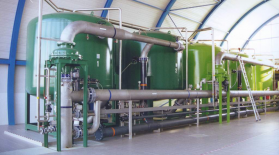biological iron and manganese removal
Reading time:These treatments apply specifically to ground water that is lacking in oxygen and that contains reduced and dissolved iron and manganese (Fe2+ and Mn2+ ions).Removal of these two elements has, for a long time, been based on physical-chemical oxidation using the oxygen contained in the air for iron and a powerful oxidant for manganese; thus, the basic system included extensive water aeration followed by filtration (at a rate of between 4 and 10 m · h–1) over sand or over a twin-layer medium; this system was frequently supplemented by the following additives, injected between aeration and filtration:
- supplementary oxidant (Cℓ2, KMnO4, O3, CℓO2), for oxidising low Fe2+ at low pH and Mn2+ in all cases;
- other reagents (pH adjustment, flocculant, etc.);
- settling or flotation for high iron content.
It was subsequently found that, under limited oxidation conditions allowing the system to reach the boundary between the field in which reduced forms (dissolved) and oxidiSed forms (precipitated) of iron and manganese co-existed, specific bacteria would develop and catalyse the oxidation of both these metals must faster than the physical-chemical method due to enzyme secretions or extracellular polymers (see iron and manganese cycle). At the same time, the precipitates formed were more compact and, therefore, less prone to fouling.
These observations led to the development of a new generation of iron and/or manganese removal plants, using the biological system and generating far better performances than conventional water treatment plant, identified in particular by filtration rates of between 15 et 50 m · h–1 depending on initial dissolved metal levels. Depending on the case concerned, the basic systems are:
- controlled aeration and filtration for biological iron removal;
- intensive aeration and filtration for biological manganese removal;
- these two treatments in series, over two stages, in the case of the simultaneous presence of Fe2+and Mn2+, because the optimum respective ORP conditions required for the oxidation and precipitation of these two elements are very different.
These processes were developed by Degrémont from the 1970’s; they were applied in gravity or pressure filters specially designed for high rate operation (Ferazur and Mangazur processes). Please refer to Iron removal and manganese removal for a detailed description.
Bookmark tool
Click on the bookmark tool, highlight the last read paragraph to continue your reading later













